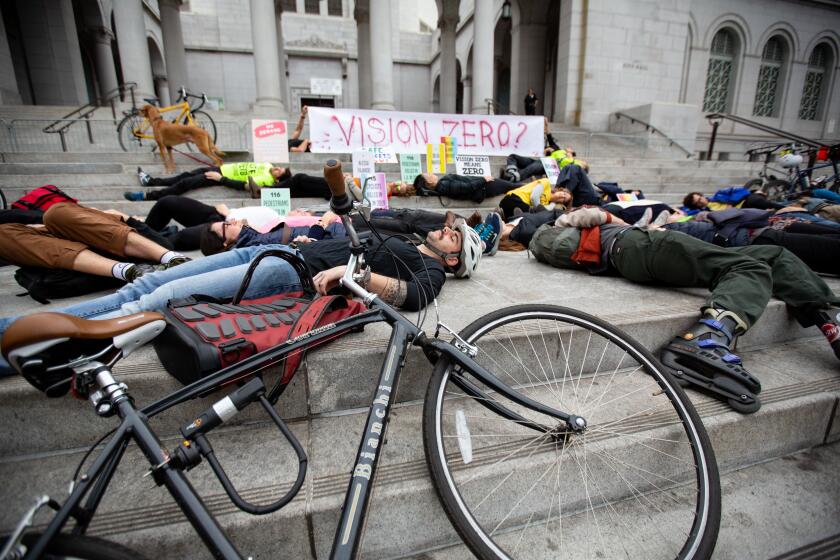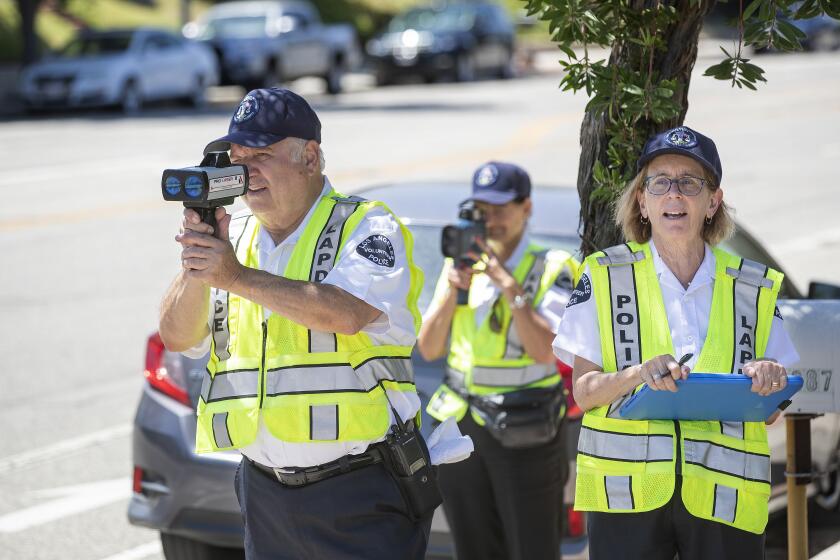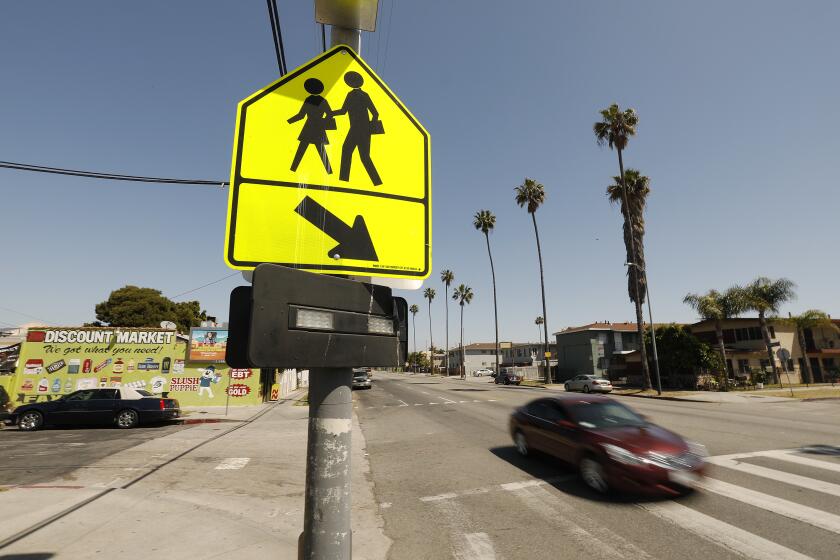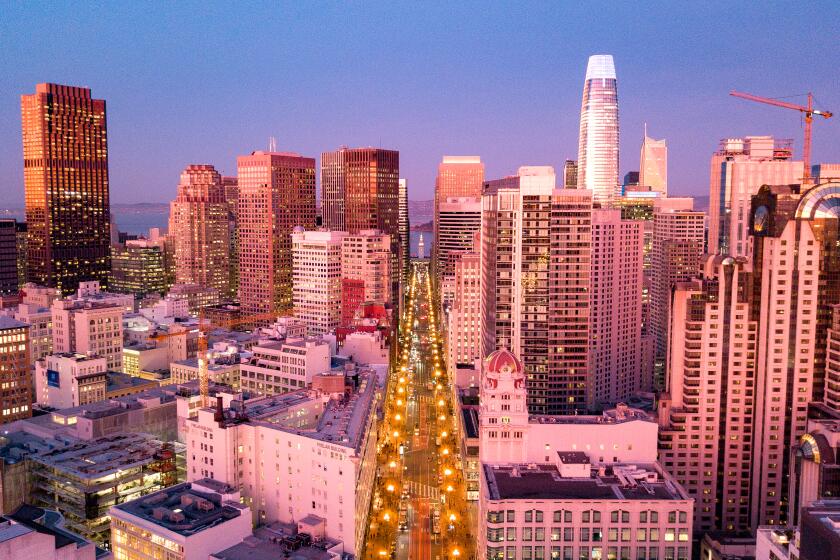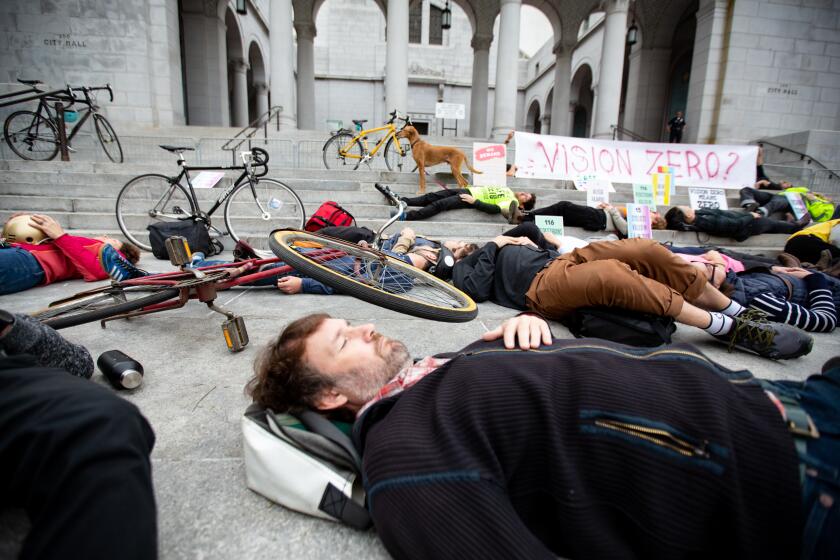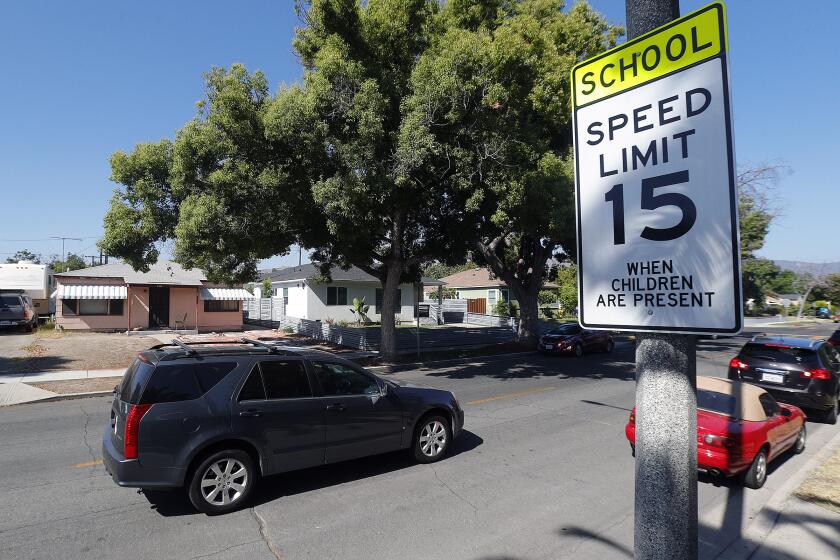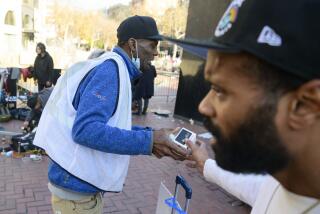San Francisco and L.A. failed to reduce pedestrian deaths. One girl’s killing shows why
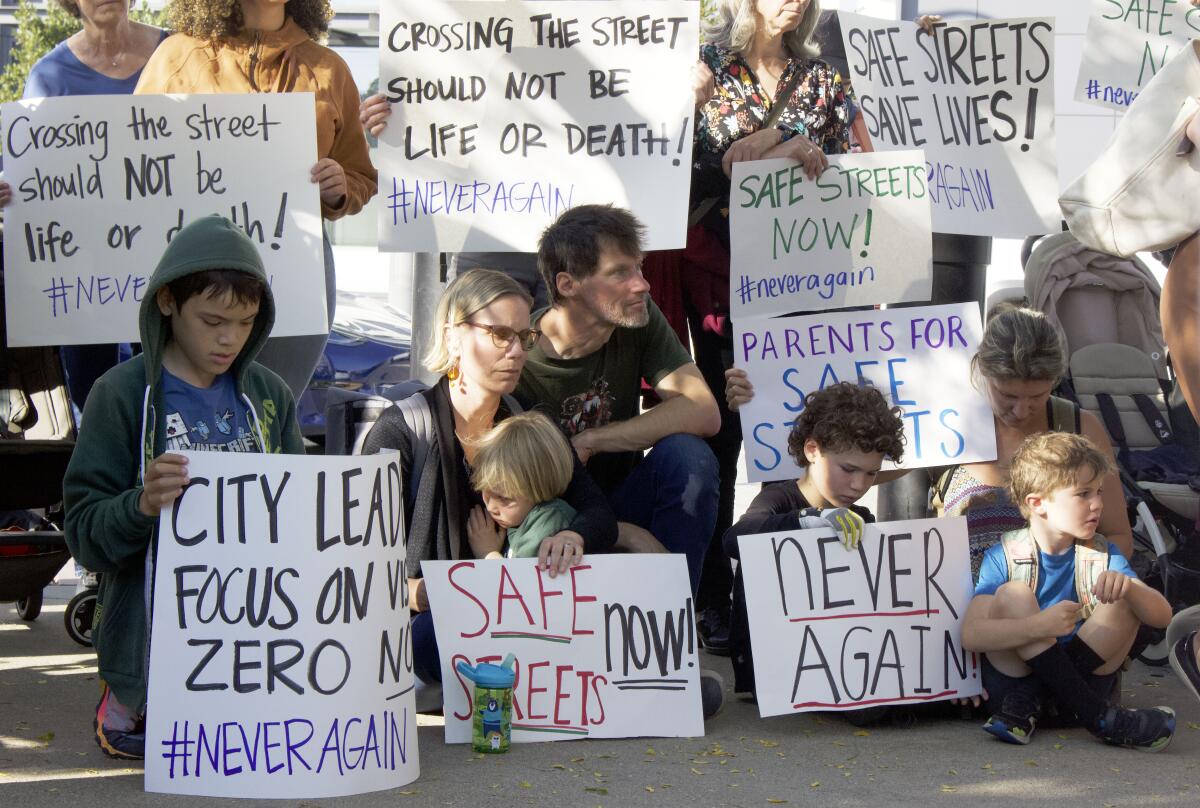
- Share via
SAN FRANCISCO — The sounds will haunt Michelle Svelti forever.
She and her boyfriend were talking in her San Francisco apartment when they heard a loud bang outside. Then came the screams.
They rushed to the window and saw that an SUV had slammed into a pole at an intersection where vehicle traffic from a nearby freeway ramp crosses a light-rail line.
A little girl in a red dress was trapped underneath, her stroller completely wrapped around the SUV.
“The parents were holding her and wailing — it was the worst sound I’ve ever heard,” Svelti said.
Svelti’s boyfriend ran downstairs to help as she recorded video on her phone, hoping that it could help detectives. Good Samaritans rushed to lift the car.
The father and 4-year-old child were taken to a hospital with life-threatening injuries. The girl did not survive.
After the Aug. 15 crash, San Francisco officials scrambled to make fast improvements to reduce conflicts between turning cars and pedestrians in the crosswalk at 4th and King streets, one of the city’s most dangerous intersections.
“It took someone to die for them to change anything,” said Fran Taylor, who tied a plush animal to a tree with a yellow ribbon at the site of a community memorial.
But San Francisco, like Los Angeles, has spent the better part of a decade making such changes as part of an ambitious pledge to reduce traffic-related deaths to zero. Neither city is close to achieving that goal.
Traffic deaths climbed again in Los Angeles in 2021, raising doubts about Mayor Eric Garcetti’s program to end such fatalities by 2025.
In fact, last year was the deadliest on San Francisco’s streets since the city committed to Vision Zero in 2014 — 39 people, including 20 pedestrians, were killed in traffic crashes, according to the San Francisco Municipal Transportation Authority. On average, 30 people die and more than 500 are severely injured in the city’s streets each year, leaving San Francisco far from reaching Vision Zero by its initial goal of 2024.
“These deaths and injuries are unacceptable and preventable,” said Erica Kato, the chief spokesperson at SFMTA. “We know a lot about what the path looks like to achieve Vision Zero. We need streets that move people, not cars. And we need cars to slow down to save lives.”
San Francisco was the second city in the nation to implement Vision Zero, an initiative originally created in Europe to eliminate pedestrian fatalities and major injuries.
California cities including Los Angeles soon followed in the quest to make communities more pedestrian-friendly. But traffic-related crashes have climbed since the pandemic, reaching a 16-year high in 2021, and officials statewide now need to reevaluate how to address street safety and meet the initiative’s ambitious goals.
In California, where speeding is one of the leading causes of traffic deaths and severe injuries, officials have been working to lower the speed limit on some problematic roads.
Assembly Bill 43, passed in 2021, allowed city officials to lower speeds by 5 mph in districts with high commercial activity. More than 40 streets in San Francisco lowered limits to 20 mph, with 23 more corridors expected to follow in the fall. In Los Angeles, officials reduced speed limits on 77 street segments, including 28 corridors with high injury rates.
Lowering the speed limit can help save lives now.
A 5-mph decrease may not sound like a lot, said Jodie Medeiros, executive director of the nonprofit Walk San Francisco, but it makes a difference when 90% of San Francisco streets enforce a 25-mph speed limit. A person struck by a vehicle traveling 40 mph has a 20% chance of surviving, according to the SFMTA. The survival rate increases to 90% if the vehicle is going 20 mph.
“Our bodies can only withstand so much impact,” Medeiros said. “If we reduce the average speed by just a few miles per hour, it’s going to reduce injury collisions by percentage points, and that’s exactly what we need to do.”
San Francisco has made efforts to do just that. The Slow Streets program, adopted in December, limits non-local traffic in certain residential areas to fewer than 1,000 cars per day and slows down speeds to about 15 mph by adding turn restrictions, speed humps and pavement markings.
Slow Streets has decreased crashes in residential areas by 48%, officials said. But drivers there are still going upward of 15 mph, leaving the most vulnerable road users feeling unsafe in their neighborhoods.
“I can’t imagine what San Francisco would be like if we didn’t have a policy like Vision Zero,” Medeiros said. “But do I think that the city is doing enough? Definitely not. The city could be doing more and faster.”
It’ll take more than safe driving PSAs to reverse the growing death toll.
A week after the deadly crash at 4th and King, drivers trumpeted their horns as transit officers, who weren’t there earlier in the month, blew their whistles and tried to soothe the traffic. The SFMTA has also moved to reduce the southbound right-turn lanes from two to one and change the traffic signal to show turning drivers a yellow arrow instead of only a green light, to call attention to people in the crosswalk.
A 71-year-old woman was arrested on suspicion of failing to yield to pedestrians and vehicular manslaughter in the crash; drugs or alcohol did not appear to be a factor, police said.
Dozens of other double-turn lanes across San Francisco will be evaluated similar to 4th and King, which is one of about 900 intersections in the city’s high-injury network, comprising the top 12% streets where 68% of all fatal and severe traffic crashes happen.
Disadvantaged communities such as low-income neighborhoods or those with older residents and people with disabilities make up more than half of the areas on San Francisco’s high-injury network. By the end of next year, streets in the network are slated for improvements such as allowing pedestrians more time to cross the street and upgraded crosswalks.
Just 10 days after the child was killed in the crosswalk, a 53-year-old man died after he was struck by a vehicle on Marin Street and Bayshore Boulevard, another dangerous intersection in the high-injury network.
Alarmed by traffic deaths and downtown gridlock, North American cities are increasingly limiting space for cars.
In Los Angeles, then-Mayor Eric Garcetti launched Vision Zero in 2015 to eliminate all traffic deaths in the city by 2025. But two years away from the deadline, and as deaths reach record highs, more Angelenos are criticizing the initiative for failing to achieve its promise.
“It’s been an abject failure,” said John Yi, the executive director of Los Angeles Walks, a nonprofit that works with immigrants and communities of color to build safer pedestrian infrastructure in their neighborhoods.
Last year, 312 people were killed in car crashes and 1,517 were seriously injured, according to the Los Angeles Department of Transportation. Bicyclists and pedestrians represented 57% of deaths and 41% of severe injuries, though most people in Los Angeles travel by car.
“We are fed up about the car-centric design of our city,” Yi said. “A lot of policies continue to support faster traffic instead of investments in infrastructure for walking, biking and transit.”
Five years ago, a 4-year-old girl was struck and killed by an SUV in a high-injury crosswalk in Koreatown as she was walking with her mother to preschool. Like the crash in San Francisco, the girl’s death spurred a reassessment of traffic safety. Across L.A. County, vehicle crashes are the leading cause of death for children.
Los Angeles’ high-injury network, last updated in 2018, identified 509 miles of unsafe streets. Officials evaluate city data every five years and expect to release the next report this year. There are currently 71 corridors and 90 intersections in the network, and 60% of them are in disadvantaged areas, according to the latest Vision Zero report.
Traffic deaths hit a 20-year high in Los Angeles last year.
Efforts to ramp up safety in Los Angeles have increased. In 2022, LADOT added more than 10 miles of new and upgraded bike lanes on Avalon Boulevard, Adams Boulevard and Anaheim Street. The city also added 11 concrete bus-boarding islands along Reseda Boulevard in the San Fernando Valley.
But much like San Francisco, Los Angeles’ goal of eliminating traffic deaths appears increasingly unattainable, frustrating transportation advocates who have long argued that Vision Zero programs are underfunded and underprioritized.
“We know what it takes to have safer streets,” Yi said. “We need to build power among people who are most affected by our upside-down transportation infrastructure so that they have a larger say in the decision-making process.”
Some advocates in California are turning toward AB 645, co-authored by Assemblymember Laura Friedman (D-Burbank), to help decrease traffic crashes. San Francisco and Los Angeles would be part of a five-year speed camera pilot program if the bill becomes law.
Under this bill, drivers caught on camera traveling at least 11 mph above the speed limit would receive a ticket in the mail. Proponents said the technology has reduced collisions by up to 60% in other cities, and it could help address “limited” police resources and reduce equity concerns about traffic stops.
But some are wary of the speed cameras and have raised concerns about privacy and excessive enforcement.
“AB 645 tickets would act as a taxing mechanism to pay for safety enhancements that the government should have previously made, ensuring that residents in communities of color will have been doubly harmed,” said Becca Cramer-Mowder, a legislative advocate at ACLU California Action.
San Jose, Oakland, Glendale and Long Beach would also be part of the pilot.
Safety advocates and some state leaders have been down this road before but are hoping the third try will be the charm.
In San Francisco, Svelti watched over the makeshift memorial at 4th and King from her window, wondering if others in the Mission Bay neighborhood were struggling too.
After a woman laid some flowers down and began to weep, Svelti went down and asked her for a hug. “I realized that there’s so many of us in the neighborhood that can’t sleep and that are constantly looking out our windows,” she said.
Among the people she has met on her visits downstairs are members of Walk San Francisco who joined the nonprofit after witnessing a fatal crash, losing a loved one in a crash or surviving one.
They include Julie Nicholson, who was running on Masonic and Oak streets when a car came speeding and hit her in 2020.
“I was in the air for a long time,” Nicholson said. “I hit the ground and I remember thinking, ‘Oh my God, I’m alive.’ ”
She was at a vigil last week for the girl killed at 4th and King, whose parents returned to Korea after the father was well enough to travel.
“At 4 years old, there’s just so many firsts yet to experience,” Nicholson said.
City and transportation officials who attended the vigil promised safety enhancements on the most dangerous roads.
“When we design our streets to be safe for kids, they become safe for everyone,” SFMTA Chair Amanda Eaken said. “I really hope that this little girl’s memory will be enough for all of us to say that never again should a child die while crossing the street.”
More to Read
Sign up for Essential California
The most important California stories and recommendations in your inbox every morning.
You may occasionally receive promotional content from the Los Angeles Times.
